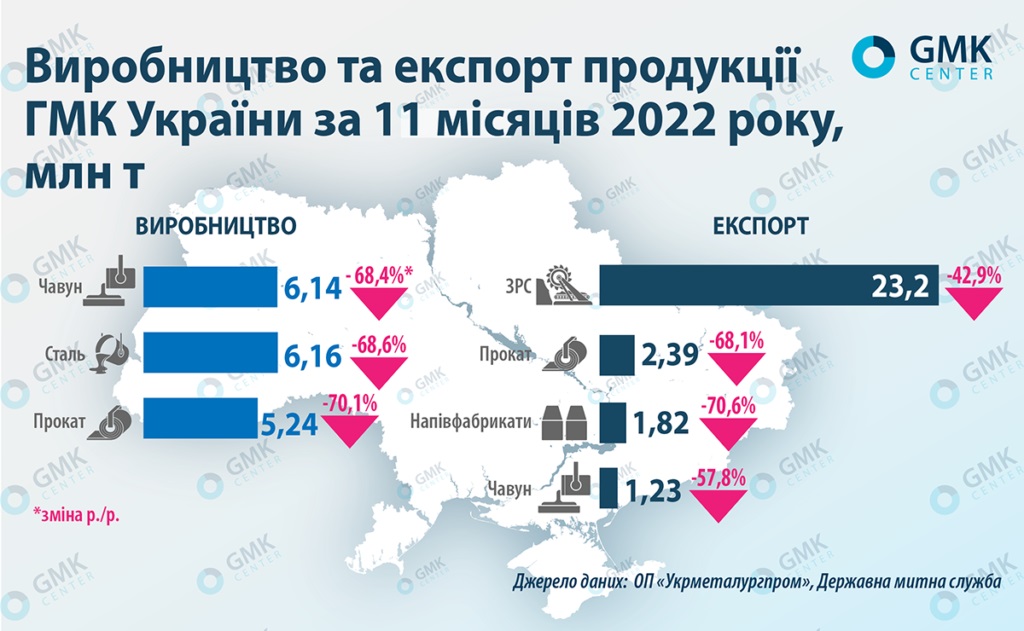Ukrainian iron and steel industry is significantly affected by problems with electricity supply and disruptions in logistics
Falling production
In autumn, the fall in the production of both steel and iron ore accelerated in Ukraine – this is related to the deterioration of demand in the European market and problems with electricity supply due to systematic Russian missile attacks.
In 11 months of 2022, the production of steel products decreased:
- pig iron – by 68.4%;
- steel – by 68.6%;
- rolled steel – by 70.1%.
In November, there were produced 313 thousand tons of steel, which is 82.0% less than in the same period of 2021. The monthly production of iron ore products fell by more than 90% in autumn compared to the pre-war period.
With the beginning of the war, Ukraine lost two powerful steel plants in Mariupol, which produced 40% of the country’s steel. Other factories have reduced the utilization of production capacities by 50% or more. Currently, the production of iron ore concentrate is almost completely stopped. Due to power outages, underground mines cannot fully operate.
Reduction of exports
The export of iron ore products for 11 months of 2022 decreased by 42.9% y/y (to 23.2 million tons). Up to 95% of iron ore exports go to EU countries.
Export of pig iron for 11 months of 2022 fell by 57.8% y/y (to 1.23 million tons), semi-finished products – by 70.6% y/y (to 1.82 million tons). During January-November 2022, 1.6 million tons of flat rolled products (-70.9% y/y) and 0.6 million tons of long-length products (-66.7% y/y) were exported.
The decrease in the export of steel products from Ukraine negatively affected global supply chains. Before the war, the EU imported more than a third (34%) of slabs from Ukraine. With the onset of a full-scale invasion, these supplies ceased, and European factories had to find other suppliers. Due to expensive logistics, the export of iron ore to China stopped – before the war, China accounted for 40-45% of Ukrainian iron ore exports.

Logistical problems
Before the full-scale invasion of the Russian Federation, 60% of iron ore, 80% of iron and steel products were exported through sea ports. With the beginning of hostilities, Ukrainian ports were blocked by the Russian military fleet, and railway transport became the main export route. According to the latest available data (October 2022), 55% of steel products are exported to the EU by rail.
Accordingly, the load on border control points, whose capacity is not calculated for such volumes of exports, has increased. Due to the different width of the railway track in Ukraine and the EU, queues of railway cars at the borders have increased.
In November 2022, the average idle time of railcars in the queue at the border was 11 days (for comparison, in June it was up to 60 days). The reduction in delay, according to analysts, is due to a decrease in cargo flows. However, the carrying capacity of the railway infrastructure has not expanded, and in the event of an increase in the volume of transportation, the problems will inevitably recur.
During the year (from May to September 2022), Ukrzaliznytsia introduced 16 conventions for the transportation of iron and steel products with the aim of reducing queues at the border. In addition, since July 1, 2022, the railway operator has increased tariffs for freight transportation by 70%, which has become a significant factor in the growth of logistics costs. As a result, steel enterprises report an increase in costs for transporting products by rail to Europe more than 4 times compared to pre-war times.
After the start of the war, Ukrainian exporters had to redirect cargo to EU seaports, in particular to Romania (Constanța), Bulgaria (Burgas), Poland (Gdynia, Gdańsk, Szczecin, Świnoujście), Croatia (Rijeka, Ploče), Germany (Hamburg, Bremerhaven, Bremen). As a result, the average distance to the port of departure for Ukrainian exporters increased by 5 times, and the cost of delivery to the port of destination increased by an average of 3-4 times.
According to market participants, EU seaports do not have the potential to serve Ukrainian exports, in particular, sufficient free capacities, and cannot receive all Ukrainian cargo, which, among other things, causes queues at Ukraine’s borders with the EU.
The blockade of sea ports leads to significant export losses in the steel industry of Ukraine. According to GMK Center estimates, the monthly amount of such losses reaches $420 million. Each month, on average, Ukraine could not produce and export 1.3 million tons of iron ore, 151 thousand tons of pig iron, 192 thousand tons of semi-finished products, and 218 thousand tons of finished steel products.
All opportunities for the country to increase production and export of iron and steel products are related to opening of Ukrainian ports. Even during the war, in fact, 60% of steel products from the country are sent to final consumers by sea – through Ukrainian ports on the Danube and sea ports in the EU.
Shortage of electricity
The destruction of the energy infrastructure due to Russian missile attacks causes a disconnection from the power supply of steel and mining enterprises.
Thus, on November 24, ArcelorMittal Kryvyi Rih announced the critical limitation of electricity consumption and the temporary stoppage of most production processes until the stabilization of energy supply in the country.
On November 23, Kametstal Iron and Steel Works of the Metinvest Group temporarily stopped production. In mid-December, the company reported that the enterprise resumed production of pig iron in one blast furnace, and the further recovery of steel and rolled products production will largely depend on the level of electricity supply deficit in the Dnipropetrovsk region.
At the same time, the Ferrexpo company in October-December 2022 reduced production of pellets by 64.2% compared to the previous quarter – to 0.3 million tons. A sharp decrease in production indicators in the fourth quarter was caused by the forced shutdown of capacities in October due to power outages. The company predicts that pellet production by the end of 2022 will be approximately 5.9-6 million tons.
Currently, there is a risk of a complete shutdown of production in the industry, which could lead to a humanitarian disaster in the regions where iron and steel enterprises operate. In the event of an energy collapse, GMK Center estimates that iron ore production could fall by 88% in 2023 compared to 2022, but if the energy system stabilizes, the rate of decline could slow to 58%.
The future of the industry
Obviously, the Ukrainian iron and steel sector will show a significant drop in production and exports. The results of work in 2023 will directly depend on solving energy supply problems, so that enterprises can receive such volumes of electricity that would allow them to resume production, as well as solving logistical issues, in particular, unblocking sea ports for the export of steel products. Continuation of hostilities will have a negative impact on the industry.
Source:



